
The New World leaf-nosed bats (Phyllostomidae) are found from southern North America to South America, specifically from the Southwest United States to northern Argentina. They are ecologically the most varied and diverse family within the order Chiroptera. Most species are insectivorous, but the phyllostomid bats include within their number true predatory species and frugivores. For example, the spectral bat, the largest bat in the Americas, eats vertebrate prey, including small, dove-sized birds. Members of this family have evolved to use food groups such as fruit, nectar, pollen, insects, frogs, other bats, and small vertebrates, and in the case of the vampire bats, even blood.

The giant golden-crowned flying fox, also known as the golden-capped fruit bat, is a species of megabat endemic to the Philippines. Since its description in 1831, three subspecies of the giant golden-crowned flying fox have been recognized, one of which is extinct. The extinct subspecies was formerly recognized as a full species, the Panay golden-crowned flying fox. Formerly, this species was placed in the genus Pteropus; while it is no longer within the genus, it has many physical similarities to Pteropus megabats. It is one of the largest bat species in the world, weighing up to 1.4 kg (3.1 lb)—only the Indian and great flying fox can weigh more. It has the longest documented forearm length of any bat species at 215 mm (8.5 in).
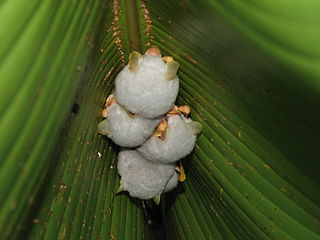
The Honduran white bat, also called the Caribbean white tent-making bat, is a species of bat in the family Phyllostomatidae. It is the only member of the genus Ectophylla. The genus and the species were both scientifically described for the first time in 1892. It has distinctive, entirely white fur, which is only found in six of the roughly 1,300 known species of bat. It constructs "tents" out of understory plant leaves by strategically cutting the leaf ribs with its teeth; it roosts in these tents during the day. It is a specialist frugivore, consuming almost exclusively the fruits of one species of fig. Females can likely become pregnant twice per year, giving birth to one offspring at a time.

The long-tongued fruit bat is a species of megabat. It is nectarivorous, feeding on nectar from primarily banana flowers. It is found in several countries in South and Southeast Asia.
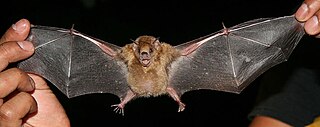
The little yellow-shouldered bat is a bat species from South and Central America. This species is a frugivore and an effective seed disperser. It roosts alone in tree cavities, on branches, vines, and under palm leaves, usually keeping to the same roosts day to day. There is evidence to suggest hypothermia is a thermoregulatory strategy to help adjust metabolic levels. In terms of mating, ambient temperature has been noted as a greater influence as compared to food availability. Its wing shape can also be affected by pregnancy in order to make flight more efficient.

The tent-making bat is an American leaf-nosed bat (Phyllostomidae) found in lowland forests of Central and South America. This medium-sized bat has a gray coat with a pale white stripe running down the middle of the back. Its face is characterized by a fleshy noseleaf and four white stripes. Primarily a frugivore, it may supplement its diet with insects, flower parts, pollen, and nectar. Its common name comes from its curious behavior of constructing tents out of large, fan-shaped leaves. These roosts provide excellent protection from the tropical rains, and a single tent roost may house several bats at once. This bat is quite common in its geographic range; hence, its conservation status is listed as Least Concern.

The great stripe-faced bat is a bat species from South and Central America, where it is found from southern Mexico to Bolivia and northwestern Brazil, as well as on Trinidad. The great stripe-faced bat is a frugivore. It is one of two species within the genus Vampyrodes the other being Vampyrodes major.
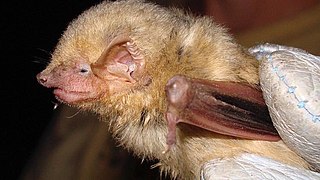
The western yellow bat is a species of vesper bat. It is found in Mexico and the southwestern United States. This species roosts in trees such as Populus fremontii, Platanus wrightii, and Quercus arizonica. If available, the western yellow bat will use the dead fronds that encircle palm trees as a roosting site.

The Toltec fruit-eating bat is a species of bat in the family Phyllostomidae. It is also sometimes called the "lowland fruit eating bat."

Sturnira is a genus of bat in the family Phyllostomidae. The genus name comes from the Latin for "starling" and refers to HMS Starling, which took part in an 1836 voyage to Brazil during which the type specimen was collected. It contains the following species:
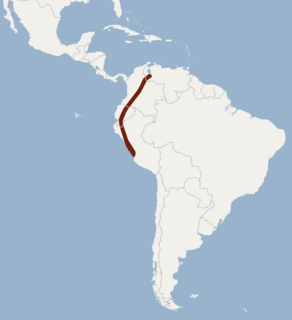
The Bogotá yellow-shouldered bat is a species of bat in the family Phyllostomidae. It is found in Colombia, Ecuador, Peru, and Venezuela at altitudes from 300 m to above 2000 m, particularly in cloud forest. The species is primarily frugivorous; it may also consume nectar and pollen.
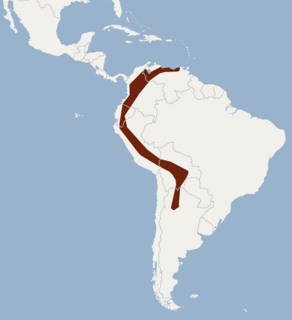
The hairy yellow-shouldered bat is a species of bat in the family Phyllostomidae native to South America. There are no recognised subspecies.

The Talamancan yellow-shouldered bat is a species of bat in the family Phyllostomidae. It is found only in Costa Rica and Panama, and there are no subspecies.
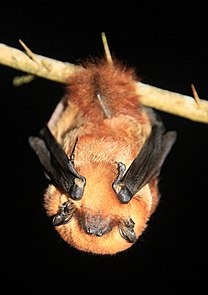
The cinnamon red bat is a species of bat in the family Vespertilionidae. It was first described from a specimen that had been collected in Chile. For more than one hundred years after its initial description, it was largely considered a synonym of the eastern red bat. From the 1980s onward, it was frequently recognized as distinct from the eastern red bat due to its fur coloration and differences in range. It has deep red fur, lacking white "frosting" on the tips of individual hairs seen in other members of Lasiurus. It has a forearm length of 39–42 mm (1.5–1.7 in) and a weight of 9.5–11.0 g (0.34–0.39 oz).
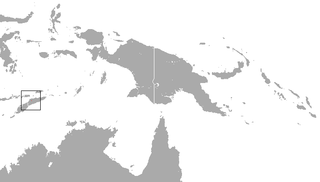
The Timorese horseshoe bat is a species of bat native to Timor-Leste.

The Mexican greater funnel-eared bat is a species of bat found in Central America. While initially and currently described as a species, from 1959–2006 it was considered a subspecies of the Mexican funnel-eared bat, Natalus stramineus.
The Bogota fruit-eating bat is a species of bat found in South America.

Sturnira parvidens is a species of leaf-nosed bat found in Central America.
Sturnira angeli, also known as the Guadeloupe yellow-shouldered bat or Angel's yellow-shouldered bat, is a species of bat in the family Phyllostomidae. It is endemic to the Lesser Antilles. As of 2018 it is listed as near threatened by the IUCN.
Paulson's yellow-shouldered bat is a species of bat in the family Phyllostomidae. It is endemic to the Lesser Antilles. According to the most recent IUCN analysis in 2019, it is near-threatened.


















